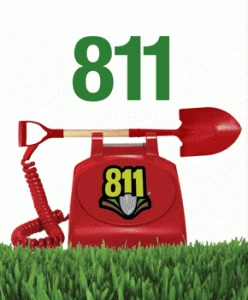An enthusiastic DIY homeowner in our area recently incurred some serious expenses during a deck expansion project. The problem: When digging the footings he cut into an underground utility line and was slapped with a hefty bill for the repairs. And sadly, the cost he incurred brought his deck project to a standstill, sapping away the money he had budgeted for the rebuild.
According to the Common Ground Alliance, an association dedicated to ensuring public safety and environmental protection, “An underground pipeline or utility is damaged once every three minutes on average across the United States, with natural gas and telecommunications lines being most commonly struck.”
Utilities can be as shallow as 18 inches or less below the ground, depending on where you live. Because of this serious risk, it’s important for both homeowners and contractors to call 811 (the national “call before you dig” number) before putting a shovel in the ground. This is a free service, so there’s no excuse not to use it.
The 811 “Call Before You Dig” number, is designated by the FCC “to protect American homeowners and professional excavators from the injuries, expenses and penalties” caused by digging related accidents that result in damages to underground utilities each year—the consequences of which include injury, penalties, repair costs and expensive and inconvenient service outages.
How far in advance should you call? State laws vary from 48 to 72 hours, most excluding weekends and legal holidays. Call 811 directly, and the customer service representative will be able to provide specific information.
“Dialing 811 prior to any digging project drastically reduces the chances of hitting an underground utility,” says John Komidar, vice president of risk control for Travelers Companies, Inc., a casualty insurance provider. “The Common Ground Alliance reports that when a call center is notified prior to digging, underground utilities are struck less than one percent of the time. This one small step can make a big difference in being responsible for thousands of dollars in repairs or worse, a life threatening accident.”
The “Call Before You Dig” number is a smart way to cover your back-side in case a dig goes awry. However, in the event that an underground utility is struck, Travelers offers the following tips to protect yourself: Contact appropriate emergency services, the utility company and your insurance company as soon as possible and document the following:
- All parties involved on the project at the time of the accident
- Witnesses – identify and get contact information
- One-Call System ticket numbers
- Type of utility line struck
- If you are on site when the utility company responds (and you should be), record the number of utility trucks, number of utility company employee, and number of repair hours
- Conversations with utility representatives, contractors and emergency responders



